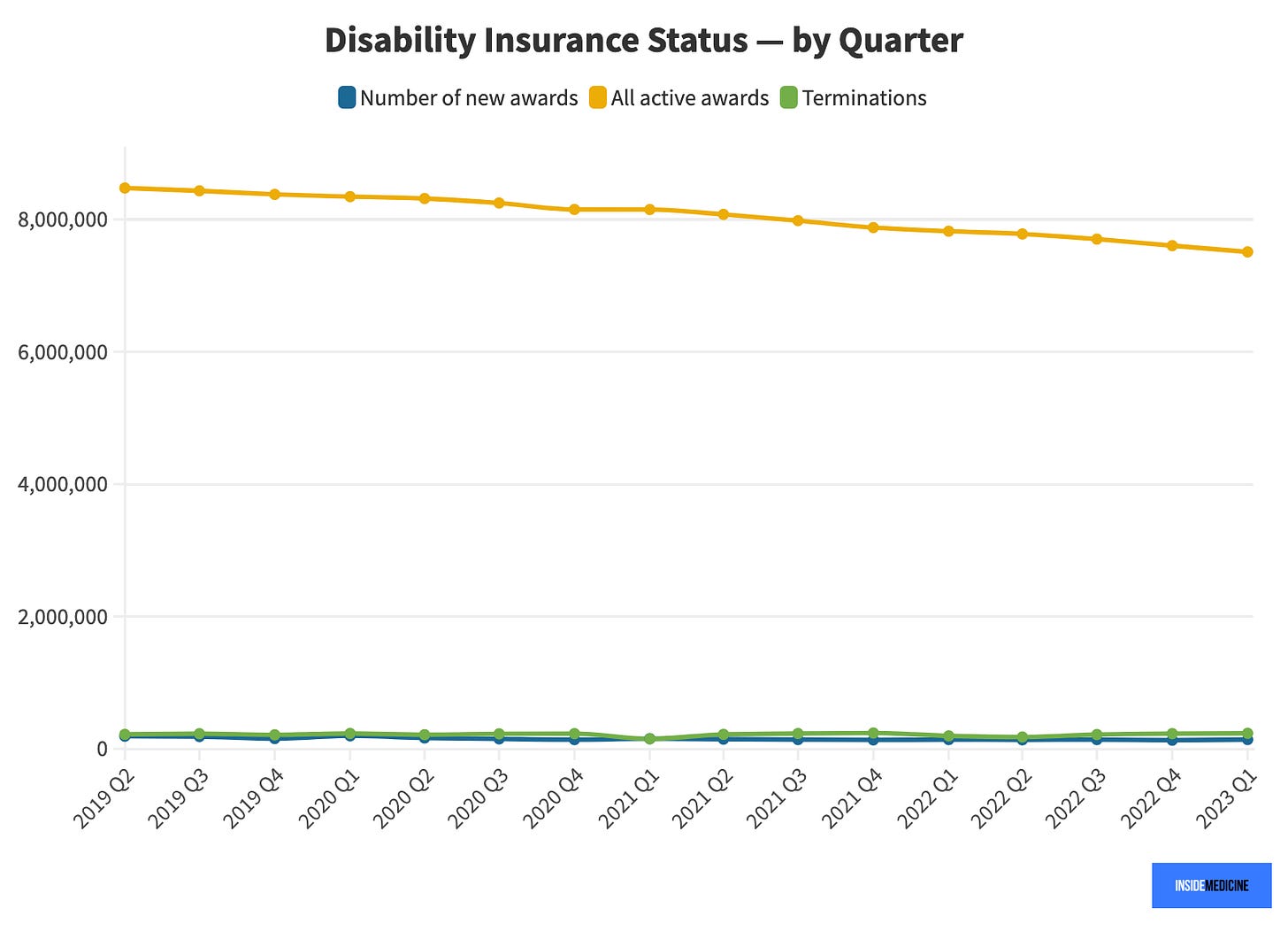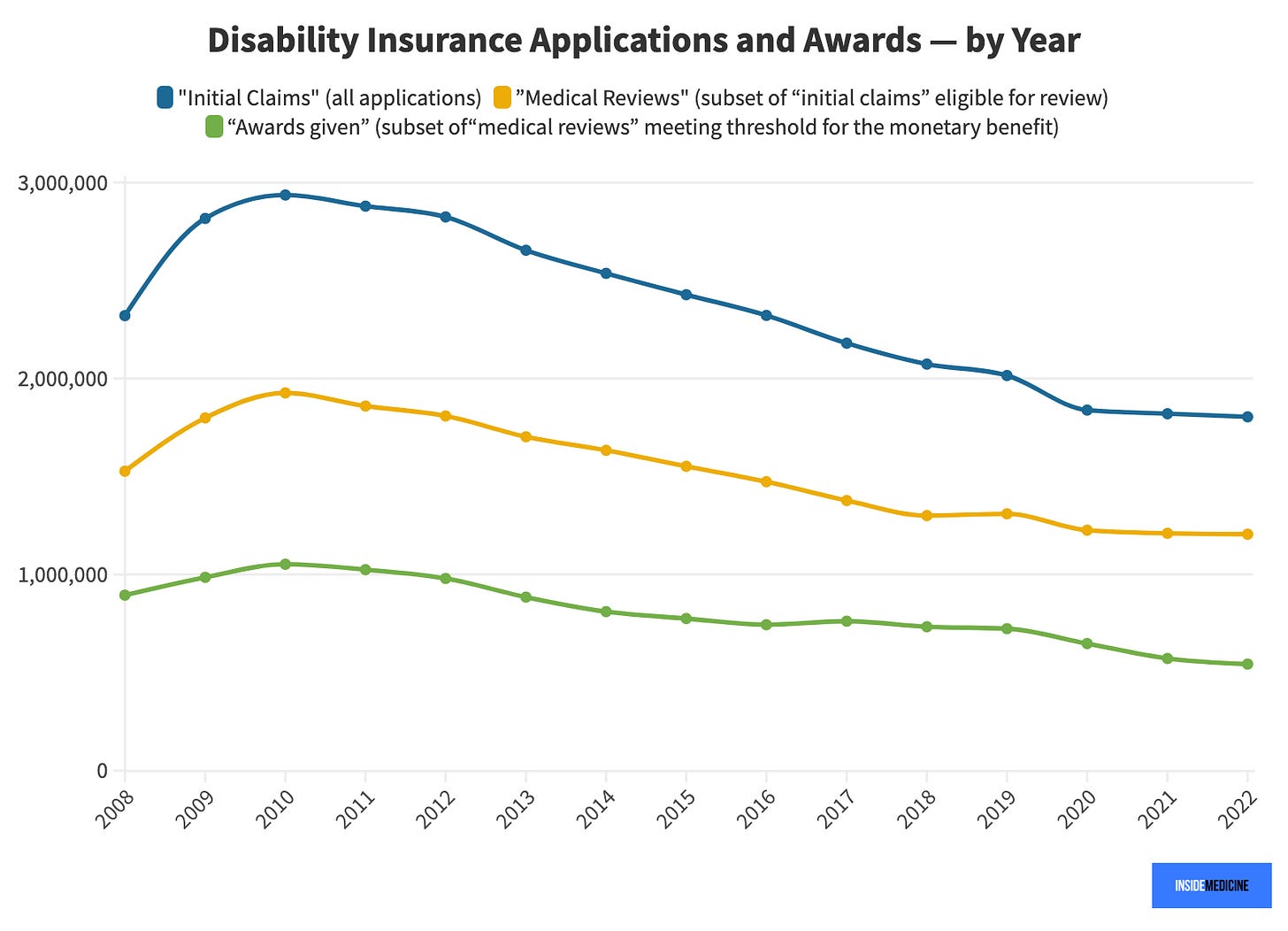Data Snapshot: Disability claims to Social Security Administration hold steady during pandemic.
Covid-19 has caused an incredibly high number of missed days of work due to sick leave. Fortunately, when the pandemic hit, many employers were able to augment and enhance their paid sick leave policies.
But what about Long Covid? Has Long Covid increased disability claims? Data from the Social Security Administration—at least so far—have not shown an increase in disability awards. That could be good news, but it’s not quite as simple as that.
As you can see in the charts above, the number of new disability awards (and the number of people who stopped getting disability awards for one reason or another) has not changed much in recent years (top chart), and zooming in on the Covid period (bottom chart) basically shows a continuation of pre-pandemic trends.
If this lack of change reflects Long Covid having caused fewer people than were feared to become disabled, that would be most welcome news. However, an uptick in claims related to Long Covid might not yet be visible in the increased disability awards as seen in datasets for other reasons. The disability award system is complicated, and the process lengthy. (A story on CNN.com describes examples of this.) Many Long Covid patients may simply have not been able to navigate the baroque process. That seems like a plausible explanation. But whether it explains a few or a great many people giving up before they even complete an application is something we just don’t know.
That said, it does not look like a spate of rejected claims is obscuring a wave of increased disability claims. If that were the case, we’d expect the data to show the number of initial claims going up, along with an increase in rejected claims. The data don’t show that happening, at least not in great degree.
The blue lines represent all people who filed a claim. The yellow lines represent those who passed the first hurdle (which has nothing to do with the medical situations; some people are not eligible for benefits for reasons having nothing to do with medical needs. For example, the government sees being gainfully employed as proof that the applicant does not really “need” the benefit.) Pre-pandemic, around 36% of disability claims to the Social Security Administration were denied up front for non-medical reasons. (That is, the yellow lines divided by the blue lines). That rate went down to 33% during the pandemic—a decrease in the successful application batting average, but not a large one.
From there, the green line shows how many people actually received an award. Pre-pandemic, around 46% of eligible claims were denied on medical grounds (that is, green divided by yellow lines). The denial rate went up to 52% during the pandemic—an increase, but, again not a massive change.
If claims had increased, but those claims were denied in droves (because Long Covid is not yet well-defined enough to be routinely covered, for example), we would expect to see a big increase in claims (blue lines, yellow lines, or both), but no corresponding increase in awards given (green lines). In some quarters, there may be a hint of that. But it looks like noise, in all honestly. Year-over-year, we just haven’t seen that telltale pattern.
Again, this lack of change could result from decreased disability claims for other (non-Covid) reasons having gone down enough to have offset Long Covid-related increases, making the net change close to zero. We just don’t know. This is an example where big data may be telling us a story in progress, but we do not yet have the whole story. Hopefully, this really is good news. But it would be premature to “dance in the end zone” and these data are just one piece of a much bigger puzzle.
If readers have experience or expertise related to this topic, I welcome your thoughts in the comment section. Thanks!







The data doesn't tell us why people have not sought aid, and it would be presumptuous to conclude that they don't need it. There are myriad reasons why pwLC have not sought assistance, starting with: newly disabled people know little about the system. People with new symptoms might experience a range of things, like hoping it will pass or being too bogged down to have the bandwidth to investigate an overly complicated and dismissive system. I'd like the perspective of disability advocates to help us understand what this data does and doesn't mean.
Another data point suggesting that long covid is not impacting the ability to work among those of working age is that the % of prime working age adults (25-54) is the highest it has been since the late '90s. I am guessing that "extremely long covid" (which is what it would take to file for disability) impacted a very very tiny group of non-seniors.